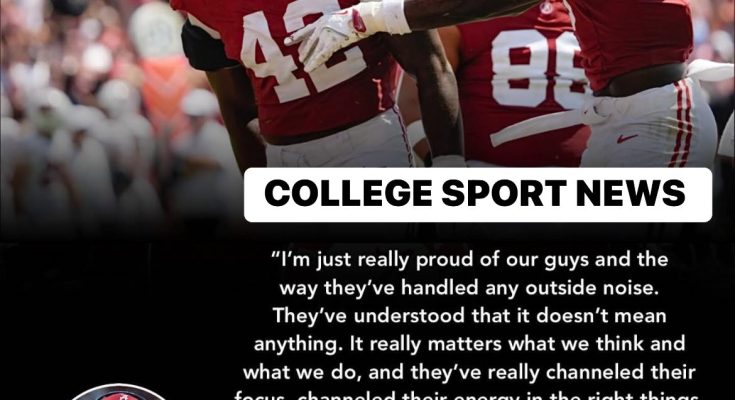Kalen DeBoer recently spoke at length about the adjustments Alabama had to make in the aftermath of their unexpected loss to Florida State, offering a comprehensive look into the internal process that unfolded as the team sought to regain its footing. His reflections not only shed light on the strategic decisions made by the coaching staff but also provided insight into the mindset and resilience of the players as they faced a setback early in the season. For a team like Alabama, which consistently operates at a championship level, any loss is significant, not just in terms of the scoreboard but also in what it reveals about the team’s preparation, execution, and adaptability. DeBoer’s commentary illustrated the multifaceted approach required to respond effectively to such a defeat, emphasizing that adjustments were made not solely on the tactical side but also in terms of team culture, communication, and mental preparation.
DeBoer emphasized that the first step in the adjustment process was a thorough assessment of the game itself. By analyzing the Florida State matchup in detail, Alabama’s coaching staff could identify both the immediate and underlying factors that contributed to the outcome. According to DeBoer, the team’s performance highlighted areas of vulnerability that had previously been underestimated, as well as moments where execution did not meet the standards expected at this level. The loss served as a wake-up call, prompting coaches and players alike to reflect on their approach, routines, and in-game decision-making. This period of reflection, DeBoer noted, was critical because it allowed the team to confront uncomfortable truths while maintaining a constructive and forward-looking attitude. Rather than dwell on the disappointment, Alabama focused on actionable lessons, which became the foundation for the adjustments that followed.
One of the most significant areas of focus, DeBoer explained, was the team’s tactical approach on both sides of the ball. Offensively, the loss to Florida State highlighted weaknesses in play-calling, timing, and execution under pressure. DeBoer noted that adjustments included refining offensive schemes to better exploit mismatches, improving communication between quarterbacks and receivers, and emphasizing situational awareness during critical moments. These changes were not superficial; they required a deep commitment from every player to internalize new responsibilities, adjust to different alignments, and respond to evolving game situations with precision. On the defensive side, Alabama recognized the need to anticipate and counter Florida State’s strategies more effectively. This led to modifications in coverage assignments, alignment strategies, and rotational patterns, all aimed at increasing flexibility and responsiveness during live gameplay. DeBoer stressed that these tactical adjustments were designed not only to correct past mistakes but also to create a more versatile and unpredictable team capable of responding dynamically to opponents’ strategies.
Equally important to tactical adjustments, DeBoer highlighted the role of mental preparation and team culture in the response to the Florida State loss. For a program with championship expectations, maintaining focus and confidence after a setback is as important as making strategic corrections. Alabama’s approach, as DeBoer explained, involved fostering a mindset of accountability, resilience, and collective ownership of outcomes. Players were encouraged to analyze their individual performances, recognize areas for improvement, and embrace the challenge of adapting to new strategies. Coaches reinforced this culture by creating an environment where constructive feedback was coupled with encouragement and support. The goal was to ensure that the team emerged from the loss not shaken but strengthened, with a renewed sense of purpose and commitment. DeBoer noted that this cultural adjustment was particularly important because it addressed the psychological dimension of recovery, helping players maintain confidence while integrating new tactical insights.
Another key element DeBoer discussed was communication. In the wake of the loss, Alabama recognized that clear, consistent, and proactive communication was critical to implementing adjustments effectively. On the practice field, this meant ensuring that every player understood their role within revised schemes and could execute responsibilities under game-like conditions. Off the field, communication extended to fostering dialogue between coaches and players, creating opportunities for feedback, clarification, and collaboration. DeBoer emphasized that improving communication was not just about conveying information but also about building trust, reinforcing accountability, and ensuring alignment across all aspects of the team’s operations. By prioritizing communication, Alabama could accelerate the integration of adjustments and minimize misunderstandings that might have contributed to the previous loss.
DeBoer also reflected on the importance of adaptability. In his analysis, Alabama’s loss to Florida State revealed that even the most successful teams must remain agile and responsive to unexpected challenges. Adjustments, therefore, were not limited to a single dimension but involved a holistic reevaluation of strategies, execution, and mindset. DeBoer explained that the coaching staff and players approached the challenge with a problem-solving mentality, focusing on identifying root causes rather than assigning blame. This approach allowed the team to make targeted changes while maintaining cohesion and morale. By treating the loss as an opportunity to learn and grow, Alabama reinforced a culture of continuous improvement, where setbacks became catalysts for development rather than sources of discouragement.
Additionally, DeBoer discussed the role of leadership in guiding the adjustment process. Team captains, veteran players, and coaching leaders all played pivotal roles in ensuring that the response to the loss was measured, constructive, and effective. Leadership involved modeling resilience, communicating expectations clearly, and encouraging teammates to embrace adjustments fully. DeBoer highlighted that leadership was particularly important in moments of pressure or uncertainty, helping the team maintain focus and composure while integrating new strategies. Through this combination of leadership, tactical refinement, mental preparation, and communication, Alabama was able to navigate the aftermath of the Florida State loss and position itself for continued success in the season.
In conclusion, Kalen DeBoer’s reflections offer a detailed and nuanced understanding of how Alabama approached the challenge of rebounding from a loss to Florida State. The adjustments were comprehensive, encompassing tactical, psychological, cultural, and communication-focused elements. By thoroughly analyzing the game, refining strategies, reinforcing team culture, improving communication, fostering adaptability, and leveraging leadership, Alabama was able to respond effectively to a setback that could have derailed the team’s momentum. DeBoer’s insights demonstrate that at the highest levels of competition, responding to adversity requires a deliberate and multifaceted approach, where every adjustment contributes to restoring performance, confidence, and cohesion. Ultimately, the team’s response highlights Alabama’s commitment to excellence, resilience, and continuous improvement, ensuring that a single loss serves not as a defeat but as a catalyst for growth and renewed focus on achieving championship goals.



